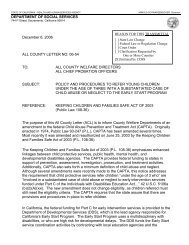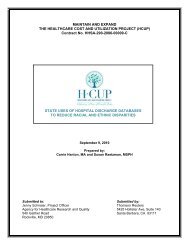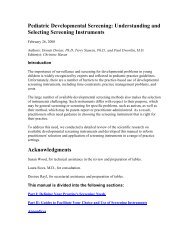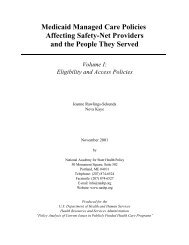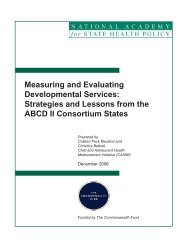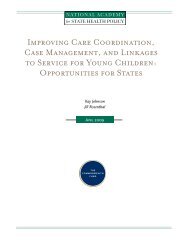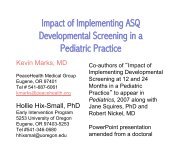Developing Federally Qualified Health Centers into Community ...
Developing Federally Qualified Health Centers into Community ...
Developing Federally Qualified Health Centers into Community ...
You also want an ePaper? Increase the reach of your titles
YUMPU automatically turns print PDFs into web optimized ePapers that Google loves.
KEY ASPECTS OF THE MODEL<br />
Participating health centers receive a capitated rate from Medicaid to hire care managers<br />
to serve beneficiaries receiving primary care from the health center, as well as those<br />
receiving primary care from private providers. In both cases, HIP care managers work<br />
closely with patients’ regular primary care practices. The design of HIP addresses some<br />
of the shortcomings found under the state’s former disease management model:<br />
• In addition to offering phone-based care, HIP care managers regularly meet face to<br />
face with clients. The care managers are geographically dispersed throughout the<br />
large, 145,000-square-mile state. No patient is more than 200 miles away from a care<br />
manager—a significant improvement over the former program.<br />
• HIP staff focus on the ―whole patient,‖ rather than just their disease. Diagnosis is one<br />
of several factors taken <strong>into</strong> account when identifying which patients receive care.<br />
Additional considerations include demographics, procedure service history, and<br />
prescription drug records. The program also allows for provider referral. This<br />
supports whole-patient care, allowing patients who may otherwise appear low-risk to<br />
receive support services.<br />
• HIP staff are familiar with local resources and are trained in using motivational<br />
interviewing to encourage healthy lifestyles.<br />
• Through HIP, the health centers currently employ 32.5 care management FTEs, with<br />
plans to employ a total of 35 FTEs to manage care for 3,200 beneficiaries.<br />
The state uses commercially available predictive modeling software (see box) to<br />
identify the 5 percent of the Passport to <strong>Health</strong> population most at risk for high costs<br />
and/or complications. In addition, primary care providers refer patients whom they<br />
believe could benefit from HIP services but were not identified through the software. To<br />
date, providers have referred only a small number of patients to HIP; as word of the<br />
program spreads, the Medicaid agency hopes to see the number of such referrals increase.<br />
As of October 2010, about 80 percent of Passport patients receiving care<br />
management through HIP were adults, and 90 percent received their primary care from a<br />
private, non-FQHC provider. 12 In general, only one-third of patients identified for the<br />
program are being actively served at any given time. Another third are in ―on-demand‖<br />
status—they have been made aware of the program and completed a questionnaire, but<br />
have chosen not to receive care management services. The other third are individuals who<br />
are unreachable or unresponsive. Panels of ―active‖ HIP patients range from 50 to 85 per<br />
care manager.<br />
6



